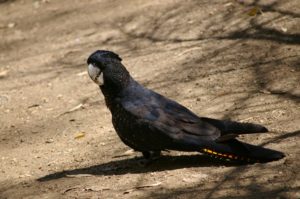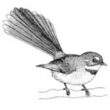The distinctive calls of forest red-tailed black cockatoos (FRTBC) are becoming a regular feature of our urban wildlife soundtrack throughout some Perth suburbs– including here in Mandurah.
Welcome to Fauna Friday.
What an impressive and special visitor to our urban areas! The forest red-tailed black cockatoo Calyptorhynchus banksii naso –known as karrak to the Noongar people- is listed as Vulnerable under the Federal Environmental Protection and Biodiversity Conservation Act (EPBC Act 1999).
It is one of three subspecies of forest red-tailed black cockatoo in WA and its distribution ranges north of Perth, south to Augusta and inland throughout its preferred habitat of marri (Corymbia calophylla), jarrah (Eucalyptus marginata) and karri (Eucalyptus diversicolor) forests of the south west of WA.
However the species’ increasing presence on the Swan Coastal Plain and suburbs of Perth tell a story of adaptation in the face of significant habitat loss. Since the 1950’s, widespread vegetation clearing has seen the species’ range contract as much as 36%, maybe more. The south west’s remnant forests containing old growth marri is critical breeding habitat – it can take well over 100 years for a marri to develop hollows large enough to safely house a breeding FRTBC.
Erection of nest boxes can help supplement breeding habitat, but installation needs to be done strategically with boxes positioned near reliable food and water resources. FRTBC feed primarily on marri and jarrah seed, which they expertly extract with their strong and dexterous beak from the hard fruit casings.
When not breeding, small flocks and family groups can range more widely from preferred nesting areas to feed on other resources – such as the seeds of the introduced Cape Lilac (Melia azedarach), which has been widely planted as an ornamental street tree throughout the suburbs of the Swan Coastal Plain. In response habitat loss and the fragmentation of remnant forest, FRTBCs have adapted to feeding on Cape Lilac seeds (and sometimes those of pines too). These introduced trees can often entice these beautiful birds to venture further into the suburbs to get a reliable feed.
